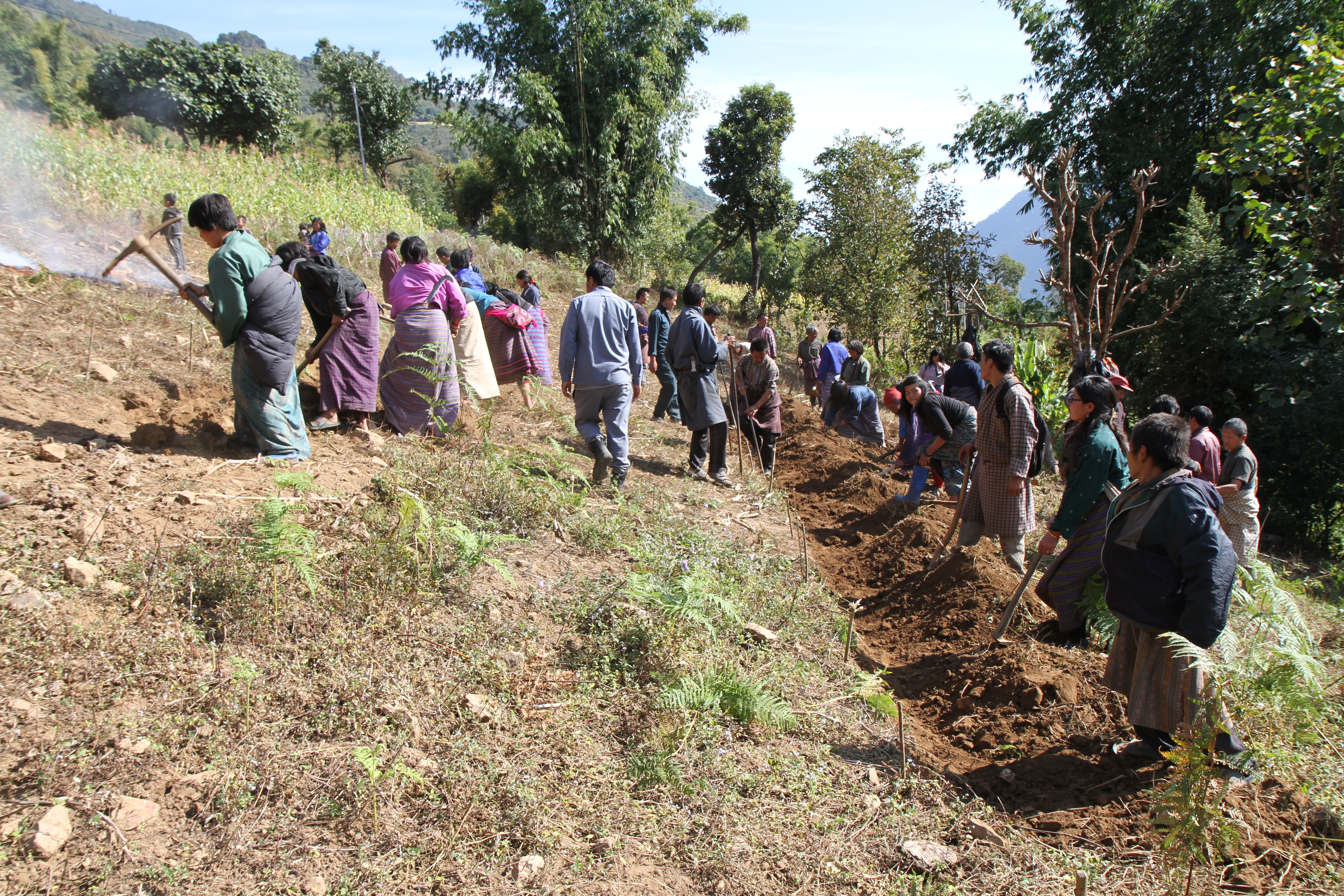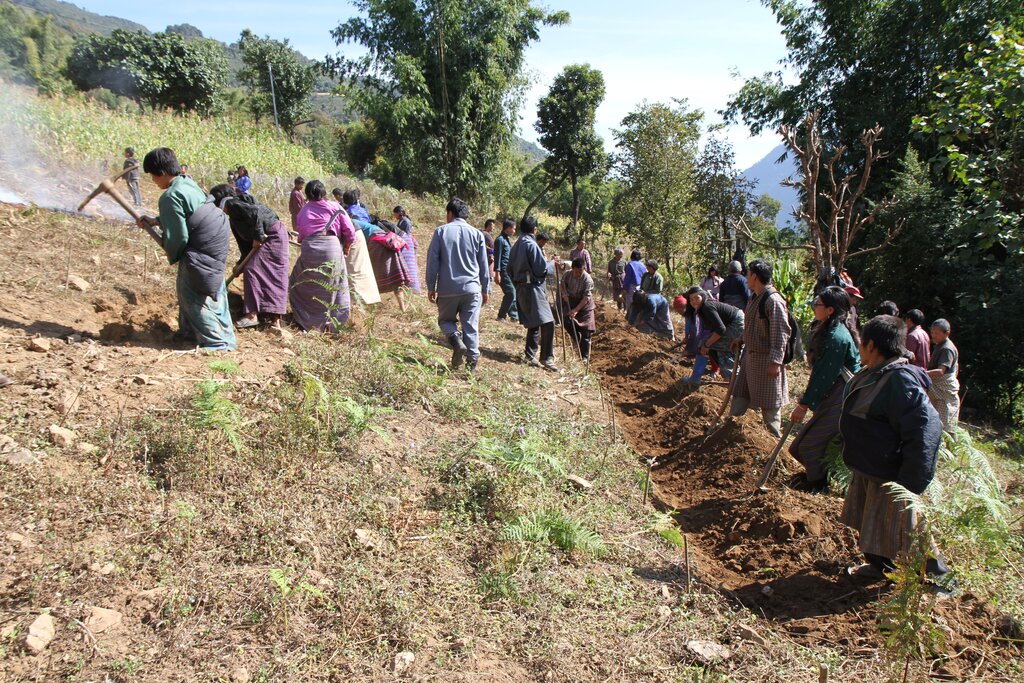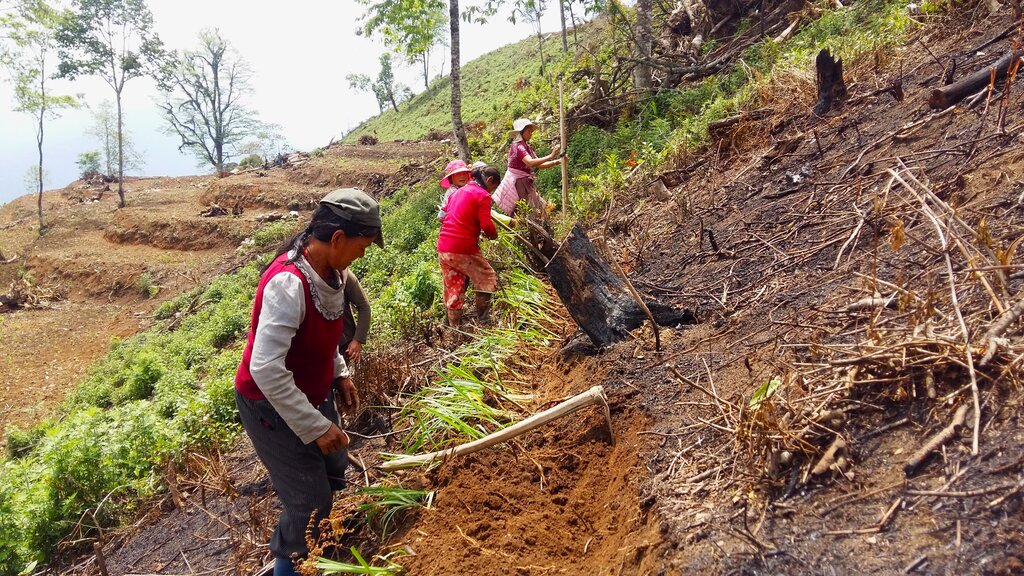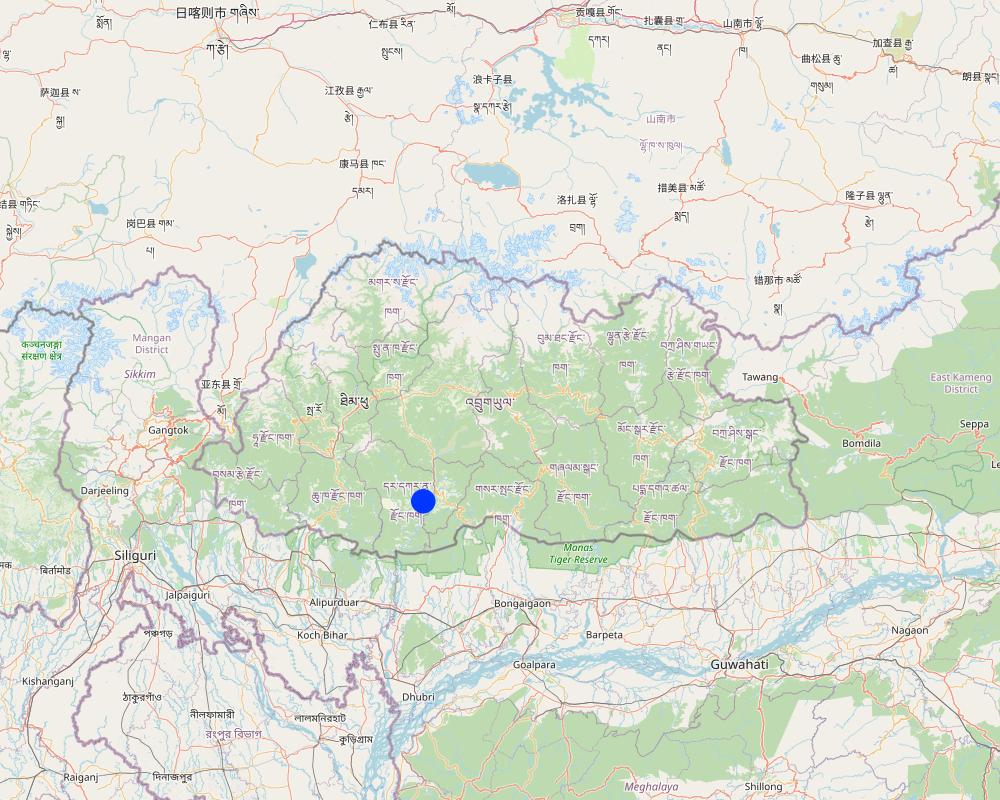Community Mobilization for SLM Interventions [ภูฏาน]
- ผู้สร้างสรรค์:
- การอัพเดท:
- ผู้รวบรวม: Nima Dolma Tamang
- ผู้เรียบเรียง: –
- ผู้ตรวจสอบ: William Critchley, Rima Mekdaschi Studer, Joana Eichenberger
Yuenten Sazhi Zinchong Laglen Thab Niyi Dhoen lu Midhey Dreltog (ཡུན་བརྟན་ས་གཞི་འཛིན་སྐྱོང་གི་འཆར་གཞི་བཙམ་ནི་ནང་བཅའ་མར་གཏོགས་ནི།)
approaches_6835 - ภูฏาน
ดูส่วนย่อย
ขยายทั้งหมด ย่อทั้งหมด1. ข้อมูลทั่วไป
1.2 รายละเอียดที่ติดต่อได้ของผู้รวบรวมและองค์กรที่เกี่ยวข้องในการประเมินและการจัดเตรียมทำเอกสารของแนวทาง
วิทยากรหลัก
ผู้ใช้ที่ดิน:
Tashi Tshering
17618478
Pangserpo Chiwog, Drujeygang Gewog, Dagana Dzongkhag
ภูฏาน
ผู้ใช้ที่ดิน:
Pem (B) Tshering
17778420
Pangserpo Chiwog, Drujeygang Gewog, Dagana Dzongkhag
ภูฏาน
ผู้ใช้ที่ดิน:
Mo Lungten
17826655
Pangserpo Chiwog, Drujeygang Gewog, Dagana Dzongkhag
ภูฏาน
ผู้ใช้ที่ดิน:
Mo Karchang
17643440
Pangserpo Chiwog, Drujeygang Gewog, Dagana Dzongkhag
ภูฏาน
ผู้ใช้ที่ดิน:
Pem (A) Tshering
77894830
Pangserpo Chiwog, Drujeygang Gewog, Dagana Dzongkhag
ภูฏาน
ชื่อของโครงการซึ่งอำนวยความสะดวกในการทำเอกสารหรือการประเมินแนวทาง (ถ้าเกี่ยวข้อง)
Strengthening national-level institutional and professional capacities of country Parties towards enhanced UNCCD monitoring and reporting – GEF 7 EA Umbrella II (GEF 7 UNCCD Enabling Activities_Umbrella II)ชื่อของโครงการซึ่งอำนวยความสะดวกในการทำเอกสารหรือการประเมินแนวทาง (ถ้าเกี่ยวข้อง)
National Soil Services Centre, Department of Agriculture, Ministry of Agriculture & Livestock (NSSC) - ภูฏาน1.3 เงื่อนไขที่เกี่ยวข้องกับการใช้ข้อมูลที่ได้บันทึกไว้ผ่านทาง WOCAT
วันที่เก็บรวบรวมข้อมูล (ภาคสนาม):
07/07/2023
ผู้รวบรวมและวิทยากรหลักยอมรับเงื่อนไขเกี่ยวกับการใช้ข้อมูลที่ถูกบันทึกผ่านทาง WOCAT:
ใช่
1.4 การอ้างอิงถึงแบบสอบถามเรื่องเทคโนโลยี SLM
2. คำอธิบายของแนวทาง SLM
2.1 การอธิบายแบบสั้น ๆ ของแนวทาง
Community mobilization in implementing sustainable land management technologies is indispensable in engaging the community to identify their priorities, resources, needs and solutions. It ultimately promotes bottom-up participation and fosters accountability.
2.2 การอธิบายอย่างละเอียดของแนวทาง
การอธิบายอย่างละเอียดของแนวทาง:
Community mobilization in implementing sustainable land management technologies involves active engagement of local communities in the planning, decision-making, implementation, and monitoring of land management. This approach recognizes the vital role of local communities in managing and conserving natural resources. By actively involving community members, SLM initiatives can be more effective and sustainable in the long-run.
With the objective of promoting a sense of unity and shared responsibility, SLM implementation in Pangserpo Chiwog of Drujeygang Gewog under Dagana Dzongkhag, has been executed through mobilization of a community group called ‘Thuenpa Puenzhi Sonam Detshen’. This group, consisting of 13 members, was initially instituted as a vegetable progressive group in 2018.
The need for SLM came to light when one of the members adopted stone bunds, inspiring the rest of the members. Subsequently, the community group members collectively initiated an SLM programme to address land degradation issues and enhance agriculture productivity. The proven SLM technologies implemented includes stone bunds, terracing, and hedgerows.
The community mobilization approach has built capacity within the community for effective land use and conservation, fostering ownership and securing the longevity of the SLM programme. The bylaws - for instance mandatory active participation of every member in community work - have been successful in upholding the integrity of the initiative, thereby ensuring effective implementation of SLM related activities.
This group mainly consists of women headed households who support each other through a self-help approach. When labour shortage is the major challenge, the self-mobilized group plays a vital role in scaling up SLM interventions and improving their own livelihoods. In most cases of SLM grouping, the groups remain intact until project support is withdrawn, but for the Thuenpa Puenzhi Sonam Detshen, the group is still functional.
2.3 รูปภาพของแนวทาง
2.5 ประเทศ ภูมิภาค หรือสถานที่ตั้งที่ได้นำแนวทางไปใช้
ประเทศ:
ภูฏาน
ภูมิภาค/รัฐ/จังหวัด: :
Dagana Dzongkhag
ข้อมูลเฉพาะเพิ่มเติมของสถานที่ตั้ง:
Pangserpo Chiwog, Drujeygang Gewog
Map
×2.6 วันที่เริ่มต้นและสิ้นสุดของแนวทาง
ระบุปีที่เริ่ม:
2019
ความคิดเห็น:
The group evolved from the vegetable group to the SLM group as the Chairman observed the effectiveness of stone bunds in land management. He initiated the construction of a stone bund which inspired other land users to adopt SLM technologies such as stone bunds, terracing and hedgerows. The land users are aware of the importance of land management to improve agricultural productivity which ensures sustainability of the approach. Furthermore, it continuously explores the market within and outside the country which motivates the group members to conserve land using the SLM measures.
2.7 ประเภทของแนวทาง
- เป็นนวัตกรรมท้องถิ่นล่าสุด/ นวัตกรรมใหม่
2.8 เป้าหมายหรือวัตถุประสงค์หลักของแนวทาง
The central goal of this approach is to foster community interaction and collaboration towards better outreach and implementation of SLM practices
2.9 เงื่อนไขที่เอื้ออำนวยหรือเป็นอุปสรรคต่อการนำเทคโนโลยีภายใต้แนวทางนี้ไปปฏิบัติใช้
บรรทัดฐานและค่านิยมทางสังคม วัฒนธรรม ศาสนา
- เอื้ออำนวย
The socio-cultural norms enable the implementation of SLM activities in the community, due to its effectiveness in mitigating land degradation issues, with no negative side impact.
การมีไว้ให้หรือการเข้าถึงแหล่งการเงินและบริการ
- เอื้ออำนวย
Initially the the government funded Nu. 200,000/- to execute the SLM technologies (stone bunds), later the group became financially stable by collecting fees (Nu.500 per member) from the group members and selling their agricultural products.
การจัดตั้งระดับองค์กร
- เอื้ออำนวย
The community have better access to gewog Renewable Natural Resources, Agriculture Research and Development Centre, and National Soil Services Centre for any kind of technical supports related to SLM
การร่วมมือหรือการทำงานประสานกันของผู้ลงมือปฏิบัติ
- เอื้ออำนวย
The land users collaborated with the Royal Government of Bhutan and Green Climate Fund project members for the execution of the community SLM interventions.
กรอบแนวทางในการดำเนินการด้านกฎหมาย (การถือครองที่ดิน สิทธิในการใช้ที่ดินและน้ำ)
- เอื้ออำนวย
The land ownerships for instance are either family or individual, posing no hindrances to adopt any kind of SLM technologies.
นโยบาย
- เอื้ออำนวย
There is no policies that hinders the SLM intervention in the community
การกำกับดูแลที่ดิน (การตัดสินใจ การนำเอาไปปฏิบัติใช้ และการบังคับใช้)
- เอื้ออำนวย
The community holds meetings every month to discuss their issues and plans. By-laws were formulated during the initiation of the approach to enable efficient decision-making and implementation of the activities. Additionally, regardless of gender, land users actively participate in the activities that were done as part of the approach.
ความรู้เกี่ยวกับ SLM การเข้าถึงการสนับสนุนด้านเทคนิค
- เอื้ออำนวย
The members were well sensitized and trained on SLM and its best technologies by the National Soil Services Centre
ตลาด (จัดซื้อปัจจัยนำเข้า ขายผลิตภัณฑ์) และราคา
- เอื้ออำนวย
The market for the community is assured through school feeding program linkage (Drujeygang Central School and Pangna Primary Schools).
ปริมาณงานที่ทำได้ กำลังคนที่มีให้
- เอื้ออำนวย
The SLM practices such as the construction of stone bunds are laborious. However, the involvement of the community and their labour contribution aids in achieving the implementation of the SLM practices.
3. การมีส่วนร่วมและบทบาทของผู้มีส่วนได้ส่วนเสียที่เกี่ยวข้อง
3.1 ผู้มีส่วนได้ส่วนเสียที่เกี่ยวข้องในแนวทางนี้และบทบาท
- ผู้ใช้ที่ดินระดับท้องถิ่นหรือชุมชนระดับท้องถิ่น
Chairman and community members (land users)
The chairman was involved in initial group formulation by gathering like-minded members, and exploring for input subsidies. Land users are involved in forming a group and cooperating to address the issues, vegetable cultivation, and marketing.
- ผู้เชี่ยวชาญ SLM หรือที่ปรึกษาการเกษตร
Gewog/Block and Dzongkhag agriculture offices
In accepting and reviewing the group formation proposal, developing by-laws , sourcing funds, exploring markets, and monitoring.
- ครู เด็กนักเรียน หรือนักศึกษา
School Administrations
For community group and school feeding program linkages
- รัฐบาลระดับท้องถิ่น
Gewog/Block Administration
In accepting and reviewing the group formation proposal, developing by-laws , sourcing funds, exploring markets, taking the concerns of land degradation to the higher authorities
- รัฐบาลแห่งชาติ (ผู้วางแผน ผู้ทำการตัดสินใจ)
Dzongkhag Adminstration
Final approval of the group formation and fund sourcing
- องค์การระหว่างประเทศ
Green Climate Fund (GCF) project
Provision of funds
3.2 การเกี่ยวข้องของผู้ใช้ที่ดินระดับท้องถิ่นหรือชุมชนระดับท้องถิ่นในช่วงต่างๆของแนวทาง
| ความเกี่ยวข้องของผู้ใช้ที่ดินระดับท้องถิ่นหรือชุมชนระดับท้องถิ่น | ระบุผู้ที่มีส่วนเกี่ยวข้องและอธิบายกิจกรรม | |
|---|---|---|
| การริเริ่มหรือการจูงใจ | ระดมกำลังด้วยตนเอง | One of the community members who is currently the chairperson adopted a SLM technology, and inspired other members. Subsequently, they further explored to implement SLM technologies in larger scales in the community. |
| การวางแผน | ปฏิสัมพันธ์ | Both the government and the land users were involved during the planning process. The government provided technical inputs whereas the land users contributed traditional knowledge. |
| การดำเนินการ | ปฏิสัมพันธ์ | Both the government and the land users were involved during the implementation of the technologies. Where the government provided technical and financial support along with machineries. The land users contributed labour and farm tools. |
| การติดตามตรวจสอบหรือการประเมินผล | ปฏิสัมพันธ์ | The community meets every month to engage in self-monitoring and evaluation of the technologies. It is followed by addressing the issues and concerns raised. The Gewog, Dzongkhag, and NSSC also conducts periodic monitoring and evaluation. |
3.3 แผนผังแสดงขั้นตอนการทำงาน (ถ้ามี)
คำอธิบาย:
Flow chart of how any SLM activities are carried out based on the approach.
ผู้เขียน:
Ongpo Lepcha
3.4 การตัดสินใจเลือกใช้เทคโนโลยี SLM
ระบุผู้ที่ทำการตัดสินใจเลือกเทคโนโลยีมากกว่าหนึ่งวิธีไปปฏิบัติใช้:
- ผู้ลงมือปฏิบัติที่เกี่ยวข้องทั้งหมดในฐานะที่เป็นส่วนรวมของแนวทาง
การอธิบาย:
The community members were sensitized on SLM by NSSC, followed by bottom-up participatory SLM action planning and field based hands on training.
ระบุว่าการตัดสินใจตั้งอยู่บนพื้นฐานของ:
- ประสบการณ์และความคิดเห็นส่วนตัว (ไม่ได้ลงบันทึกไว้)
4. การสนับสนุนด้านเทคนิค การสร้างขีดความสามารถ และการจัดการด้านความรู้
4.1 การสร้างขีดความสามารถ / การอบรม
ได้มีการจัดอบรมให้แก่ผู้ใช้ที่ดินหรือผู้มีส่วนได้ส่วนเสียคนอื่น ๆ หรือไม่:
ใช่
ให้ระบุว่าใครเป็นผู้ได้รับการอบรม:
- ผู้ใช้ที่ดิน
- เจ้าหน้าที่ภาคสนาม / ที่ปรึกษา
ถ้าเกี่ยวข้อง ให้ระบุ เพศ อายุ สถานภาพ ชาติพันธุ์ เป็นต้น:
All the members (both male and female) were trained.
รูปแบบการอบรม:
- ใช้พื้นที่ทำการสาธิต
- จัดการประชุมสู่สาธารณชน
หัวข้อที่พูด:
What actually SLM is, why SLM is important and required, and the best proven SLM technologies that are being implemented in Bhutan.
4.2 การบริการให้คำแนะนำ
ผู้ใช้ที่ดินมีการเข้าถึงการรับบริการให้คำปรึกษาหรือไม่:
ใช่
ระบุว่ามีบริการให้คำปรึกษาหรือไม่:
- ไปเยี่ยมชมสถานที่
การอธิบาย/แสดงความคิดเห็น:
The advisory services on the technology and management were provided to farmers on land users' fields by Agriculture Extension Officers.
4.3 การเสริมความแข็งแกร่งให้กับสถาบัน (การพัฒนาองค์กร)
สถาบันได้รับการจัดตั้งขึ้นมาหรือเสริมความแข็งแกร่งโดยแนวทางนี้หรือไม่:
- ใช่ ปานกลาง
ระบุระดับของสถาบันที่ได้รับการเสริมความแข็งแกร่งหรือจัดตั้งขึ้นมา:
- ท้องถิ่น
อธิบายถึงสถาบัน บทบาทและความรับผิดชอบ สมาชิก เป็นต้น:
The institution is known by the name "Thuenpa Puenzhi Sanam Detshen" in the surrounding community. There are 13 members including the chairperson of the group. The chairperson's responsibility is to coordinate and address all community-related activities and concerns. He also oversees the institution's financial planning. The member's job is to cooperate with the chairperson and encourage one another in difficult times.
ระบุประเภทของการให้ความช่วยเหลือสนับสนุน:
- ด้านการเงิน
- การสร้างขีดความสามารถ / การอบรม
- อุปกรณ์
- labour-sharing (Local name: Lagtshab)
ให้รายละเอียดเพิ่มเติม :
The institution provides financial aid. Additionally, they engage in labour-sharing (lagtshab) where the land users rotate working on each other's fields to complete the work faster.
4.4 การติดตามตรวจสอบและประเมินผล
การติดตามตรวจสอบและประเมินผลเป็นส่วนหนึ่งของแนวทางหรือไม่:
ใช่
ความคิดเห็น:
The monitoring and evaluation are part of the approach. The land users get together once a month to review the activities conducted and plan future activities preventing recurring issues to strengthen the effectiveness of the approach.
ถ้าตอบว่าใช่ แสดงว่าการจัดเตรียมเอกสารนี้มุ่งหวังที่จะเอาไปใช้สำหรับการติดตามตรวจสอบและประเมินผลใช่หรือไม่:
ไม่ใช่
4.5 การวิจัย
การวิจัยเป็นส่วนหนึ่งของแนวทางหรือไม่:
ไม่ใช่
5. การสนับสนุนด้านการเงินและวัสดุอุปกรณ์
5.1 ระบุงบประมาณประจำปีสำหรับแนวทาง SLM นี้
ถ้าหากว่างบประมาณประจำปีไม่เป็นที่ทราบแน่นอน ให้ระบุช่วงลงไป:
- < 2,000
แสดงความคิดเห็น (แหล่งของการระดมทุน ผู้บริจาคคนสำคัญ):
The government funded one time during the initial implementation of the technology. However, there is no annual budget allocated for the group now.
5.2 การสนับสนุนด้านการเงิน / วัสดุอุปกรณ์ให้แก่ผู้ใช้ที่ดิน
ผู้ใช้ที่ดินได้รับการสนับสนุนด้านการเงิน / วัสดุอุปกรณ์ไปปฏิบัติใช้เทคโนโลยีหรือไม่:
ใช่
ถ้าใช่ ให้ระบุประเภทของการสนับสนุน เงื่อนไขและผู้จัดหามาให้:
They were provided with Nu. 200,000/- to implement the technology through GCF project.
5.3 เงินสนับสนุนสำหรับปัจจัยนำเข้า (รวมถึงแรงงาน)
- อุปกรณ์
| ระบุปัจจัยนำเข้าที่ได้รับการสนับสนุน | เห็นด้วยระดับไหน | ระบุเงินสนับสนุน |
|---|---|---|
| เครื่องจักร | ได้รับการช่วยเหลือทางการเงินบางส่วน | Power tiller was partly financed by the government. (Farmers and the government split the cost by 50%) |
- การเกษตร
| ระบุปัจจัยนำเข้าที่ได้รับการสนับสนุน | เห็นด้วยระดับไหน | ระบุเงินสนับสนุน |
|---|---|---|
| เมล็ด | ได้รับการช่วยเหลือทางการเงินแบบเต็ม | Initially all the seeds were provided by the government later it was stopped as the land users became financially stable to afford the seeds. |
- โครงสร้างพื้นฐาน
| ระบุปัจจัยนำเข้าที่ได้รับการสนับสนุน | เห็นด้วยระดับไหน | ระบุเงินสนับสนุน |
|---|---|---|
| Greenhouse | ได้รับการช่วยเหลือทางการเงินบางส่วน | The government paid 80% of the greenhouse's cost, and farmers paid 20%. |
ถ้าแรงงานโดยผู้ใช้ที่ดินเป็นปัจจัยนำเข้าที่มีอยู่มากมาย ระบุด้วยว่าเนื่องจาก:
- สมัครใจ
5.4 เครดิต
มีการจัดหาเครดิตมาให้ภายใต้แนวทาง SLM หรือไม่:
ใช่
ถ้าใช่ ระบุเงื่อนไข (อัตราดอกเบี้ย การชำระคืน):
The credit was provided to the community members from the group fund of the group without any interest.
ระบุผู้ให้เครดิต:
Chairperson and assistant
ระบุผู้รับเครดิต:
Group members including the chairperson.
5.5 แรงจูงใจหรือเครื่องมืออื่น ๆ
แรงจูงใจหรือเครื่องมืออื่น ๆ ได้ถูกนำไปใช้ส่งเสริมการใช้เทคโนโลยี SLM หรือไม่:
ไม่ใช่
6. การวิเคราะห์ผลกระทบและการสรุป
6.1 ผลกระทบของแนวทาง
ทำให้ผู้ใช้ที่ดินระดับท้องถิ่นมีอำนาจขึ้น ปรับปรุงการเข้าร่วมของผู้มีส่วนได้ส่วนเสียให้ดีขึ้นหรือไม่:
- ไม่ใช่
- ใช่ เล็กน้อย
- ใช่ ปานกลาง
- ใช่ อย่างมาก
The land users are now empowered and are able to implement SLM technologies on their own, because of capacity built through SLM sensitization and hand-on-training.
ช่วยในการตัดสินใจโดยดูจากหลักฐาน ได้หรือไม่:
- ไม่ใช่
- ใช่ เล็กน้อย
- ใช่ ปานกลาง
- ใช่ อย่างมาก
The approach enabled land users to make evidence-based decisions. For example, the land users grew certain crops to be sold to the local market. However, the members of other communities started growing the same types of crops. Therefore, to reduce market competition the land users opted for different crops that are not grown by other groups. Also, linking with school feeding program was also a best evident decision.
ช่วยให้ผู้ใช้ที่ดินนำเอาเทคโนโลยี SLMไปใช้และบำรุงรักษาสภาพไว้ได้หรือไม่:
- ไม่ใช่
- ใช่ เล็กน้อย
- ใช่ ปานกลาง
- ใช่ อย่างมาก
The group members collectively could source funds for SLM. The technology implementation through labour sharing was possible only due to the group members cohesiveness.
ปรับปรุงความร่วมมือกันและการดำเนิน งานของ SLM ได้อย่างมีประสิทธิผลหรือไม่:
- ไม่ใช่
- ใช่ เล็กน้อย
- ใช่ ปานกลาง
- ใช่ อย่างมาก
The labour sharing strategy proved best in effective cost management (cost sharing).
ระดมกำลังหรือปรับปรุงการเข้าถึงแหล่ง เงินทุนสำหรับการดำเนินการ SLM หรือไม่:
- ไม่ใช่
- ใช่ เล็กน้อย
- ใช่ ปานกลาง
- ใช่ อย่างมาก
The group sourced Nu. 200,000/- for the implementation of SLM technologies. Currently, the group makes Nu. 30,00,000/- a year, which they divide among themselves and save a certain amount to be used to maintain the technologies and as an emergency fund.
ปรับปรุงความรู้และความสามารถของผู้ใช้ที่ดินในการดำเนินการ SLM หรือไม่:
- ไม่ใช่
- ใช่ เล็กน้อย
- ใช่ ปานกลาง
- ใช่ อย่างมาก
Capacity built through SLM sensitization, hand-on-training, and implementation.
ปรับปรุงความรู้และความสามารถของผู้มีส่วนได้ส่วนเสียคนอื่น ๆ ให้ดีขึ้นหรือไม่:
- ไม่ใช่
- ใช่ เล็กน้อย
- ใช่ ปานกลาง
- ใช่ อย่างมาก
The capacities of local government officials were developed, while making their presence during the program.
ทำให้ผู้ใช้ที่ดินระดับท้องถิ่นมีอำนาจขึ้น ปรับปรุงการเข้าร่วมของผู้มีส่วนได้ส่วนเสียให้ดีขึ้นหรือไม่:
- ไม่ใช่
- ใช่ เล็กน้อย
- ใช่ ปานกลาง
- ใช่ อย่างมาก
Based on the community's interest and motivation to improve agricultural productivity, other stakeholders are convinced to support and collaborate with them.
ช่วยบรรเทาความขัดแย้งหรือไม่:
- ไม่ใช่
- ใช่ เล็กน้อย
- ใช่ ปานกลาง
- ใช่ อย่างมาก
The labour sharing mechanism through this approach has mitigated social conflicts especially due to labour shortage.
ทำให้กลุ่มด้อยโอกาสมีอำนาจทางสังคมและเศรษฐกิจหรือไม่:
- ไม่ใช่
- ใช่ เล็กน้อย
- ใช่ ปานกลาง
- ใช่ อย่างมาก
The group members mainly consists of women headed households.
ปรับปรุงความทัดเทียมกันด้านเพศและให้อำนาจแก่ผู้หญิงและเด็กผู้หญิงหรือไม่:
- ไม่ใช่
- ใช่ เล็กน้อย
- ใช่ ปานกลาง
- ใช่ อย่างมาก
Both male and female have equal rights to be part of the group. Initially, the group started with an equal number of male and female.
ส่งเสริมให้เยาวชนหรือบุตรหลานของผู้ใช้ที่ดินให้เข้าร่วมใน SLM:
- ไม่ใช่
- ใช่ เล็กน้อย
- ใช่ ปานกลาง
- ใช่ อย่างมาก
Majority of the children are in schools/colleges. But, they somehow get to engage in SLM program during their vacations representing their parents and relatives. Few youth living in the community are also engaged. Hence, the next generation land users are encouraged.
ปรับปรุงประเด็นของการถือครองที่ดินหรือสิทธิในการใช้ ซึ่งขัดขวางการนำเทคโนโลยีไปใช้ให้ดีขึ้น:
- ไม่ใช่
- ใช่ เล็กน้อย
- ใช่ ปานกลาง
- ใช่ อย่างมาก
The land ownerships are either family or individual. So, there was no prior issues in land tenure or user rights.
นำไปสู่ความมั่นคงด้านอาหารหรือปรับปรุงโภชนาการให้ดีขึ้น:
- ไม่ใช่
- ใช่ เล็กน้อย
- ใช่ ปานกลาง
- ใช่ อย่างมาก
Before the community mobilization approach, agricultural activity was mainly for self-consumption. The implementation of SLM with this approach has seen increased agricultural productivity even at this initial stage, leading to market-oriented farming, improved household income, improved food and nutrition security.
ปรับปรุงการเข้าถึงตลาดหรือไม่:
- ไม่ใช่
- ใช่ เล็กน้อย
- ใช่ ปานกลาง
- ใช่ อย่างมาก
The approach improved land users' access to the market through school feeding program linkage.
นำไปสู่การเข้าถึงเรื่องน้ำและสุขาภิบาลได้ดีขึ้นหรือไม่:
- ไม่ใช่
- ใช่ เล็กน้อย
- ใช่ ปานกลาง
- ใช่ อย่างมาก
The water harvesting technology implemented through the approach provides irrigation water to the land users' fields.
นำไปสู่การใช้ที่ดินอย่างยั่งยืนหรือแหล่งพลังงานหรือไม่:
- ไม่ใช่
- ใช่ เล็กน้อย
- ใช่ ปานกลาง
- ใช่ อย่างมาก
The SLM technologies implemented by the land users in this community is not very related to the sustainable energy uses.
ปรับปรุงความสามารถของผู้ใช้ที่ดินในการปรับตัวให้เข้ากับการเปลี่ยนแปลงของสภาพภูมิอากาศหรือสภาพที่รุนแรงและภัยพิบัติหรือไม่:
- ไม่ใช่
- ใช่ เล็กน้อย
- ใช่ ปานกลาง
- ใช่ อย่างมาก
Adverse effects of climate change such as erratic rainfall reduced through SLM, especially due to sloping of agricultural lands.
นำไปสู่โอกาสในการจ้างงาน รายได้หรือไม่:
- ไม่ใช่
- ใช่ เล็กน้อย
- ใช่ ปานกลาง
- ใช่ อย่างมาก
The approach has significantly improved the land users' income as the technologies increased cultivable area, improved irrigation and eased farming. All these lead to an increase in agricultural productivity and household income.
6.2 แรงจูงใจหลักของผู้ใช้ที่ดินเพื่อที่จะนำ SLM ไปปฏิบัติใช้
- การผลิตที่เพิ่มขึ้น
To have more cultivable lands, and enhance nutrient conservation (Soil loss).
- กำไร (ความสามารถ) อัตราส่วนค่าใช้จ่ายต่อผลประโยชน์ที่เพิ่มขึ้น
Large scale vegetable cultivation leading to increased farm income.
- การเสื่อมของที่ดินลดลง
To maintain the quality of the soil and land through control of nutrient loss, loss of productive lands, and higher vegetation coverage.
- ภาระงานลดลง
Enhanced farm mechanization and workability leads to reducing number of labors
- ความรู้และทักษะ SLM ที่เพิ่มพูนขึ้น
The land users have had no formal trainings or exposure to SLM earlier.
- การปรับปรุงด้านสุทรียภาพ
The lands transformed through SLM intervention adds aesthetic value to the community.
6.3 ความยั่งยืนของกิจกรรมของแนวทาง
ผู้ใช้ที่ดินสามารถทำให้สิ่งต่างๆ ที่ได้ปฏิบัติใช้โดยแนวทางนี้ยั่งยืนได้หรือไม่ (โดยไม่มีการสนับสนุนจากภายนอก):
- ใช่
ถ้าตอบว่าใช่ ให้อธิบายว่าอย่างไร :
The group is financially stable and has strong cooperation and interaction among the members
6.4 จุดแข็งและข้อได้เปรียบของแนวทาง
| จุดแข็ง / ข้อได้เปรียบของแนวทางในทัศนคติของผู้ใช้ที่ดิน |
|---|
| The land users are self-sufficient in vegetables, and improved health and well-being of their families. |
| The cooperation and interaction among the group members have been enhanced as the approach involves working in a group where they help each other to achieve a common goal. |
| The approach has made the land users financially stable due to the income generated from selling vegetables. |
| Due to bulk production in a community, the land users are able to access markets having demand for more quantities of vegetables such as school feeding programmes. |
| จุดแข็ง / ข้อได้เปรียบของแนวทางในทัศนคติของผู้รวบรวมหรือวิทยากรหลัก |
|---|
| The community has a capable leader, which is important to guide the group in terms of difficulties and prevent failure of the approach. |
| The agricultural production has drastically increased, especially winter crops leading to reduced import. |
6.5 จุดอ่อน / ข้อเสียเปรียบของแนวทางและวิธีในการแก้ไข
| จุดอ่อน / ข้อเสียเปรียบในทัศนคติของผู้ใช้ที่ดิน | สามารถแก้ไขปัญหาได้อย่างไร |
|---|---|
| The potato production is higher than the market demand | Exploring markets beyond the community and local markets |
| จุดอ่อน / ข้อเสียเปรียบในทัศนคติของผู้รวบรวมหรือวิทยากรหลัก | สามารถแก้ไขปัญหาได้อย่างไร |
|---|---|
| Limited market (Only two schools and few local markets) | Explore markets beyond local markets |
7. การอ้างอิงและการเชื่อมต่อ
7.1 วิธีการหรือแหล่งข้อมูล
- ไปเยี่ยมชมภาคสนาม การสำรวจพื้นที่ภาคสนาม
Five informants
- การสัมภาษณ์กับผู้ใช้ที่ดิน
Five land users were interviewed
- การเก็บรวบรวมมาจากรายงานและเอกสารที่มีอยู่
SLM manuals and guidelines
7.2 การอ้างอิงถึงสิ่งตีพิมพ์
ชื่อเรื่อง ผู้เขียน ปี ISBN:
Wangdi, K. (2022). Promoting local farm produce in schools. BBS. Retrieved from http://www.bbs.bt/news/?p=165872
ช่องทางในการสืบค้น และราคา:
http://www.bbs.bt/news/?p=165872
ชื่อเรื่อง ผู้เขียน ปี ISBN:
National Soil Service Center. (2011). Bhutan Catalogue of Soil and Water Conservation Approaches and Technologies: Best Practices and Guidelines from Bhutan for Sustainable Land Management on Steep to Very Steep Slopes. National Soil Services Centre (NSSC), Department of Agriculture, Ministry of Agriculture and Forests, Royal Government of Bhutan, Thimphu.
ช่องทางในการสืบค้น และราคา:
https://www.wocat.net/documents/140/Bhutan_catalogue_of_SLM_Technologies_and_Approaches.pdf
7.3 เชื่อมโยงกับข้อมูลที่มีอยู่บนออนไลน์
ชื่อเรื่องหรือคำอธิบาย:
Sustainable Land Managements in Bhutan
URL:
https://www.cif.org/sites/cif_enc/files/knowledge-documents/summary_brief_land_management_bhutan.pdf
ชื่อเรื่องหรือคำอธิบาย:
Community Participatory Sustainable Land Management Byelaw Formulation in the highland of central Ethiopia
URL:
https://www.ajol.info/index.php/acsj/article/view/101368/90558
ลิงก์และโมดูล
ขยายทั้งหมด ย่อทั้งหมดลิงก์
ไม่มีลิงก์
โมดูล
ไม่มีโมดูล






